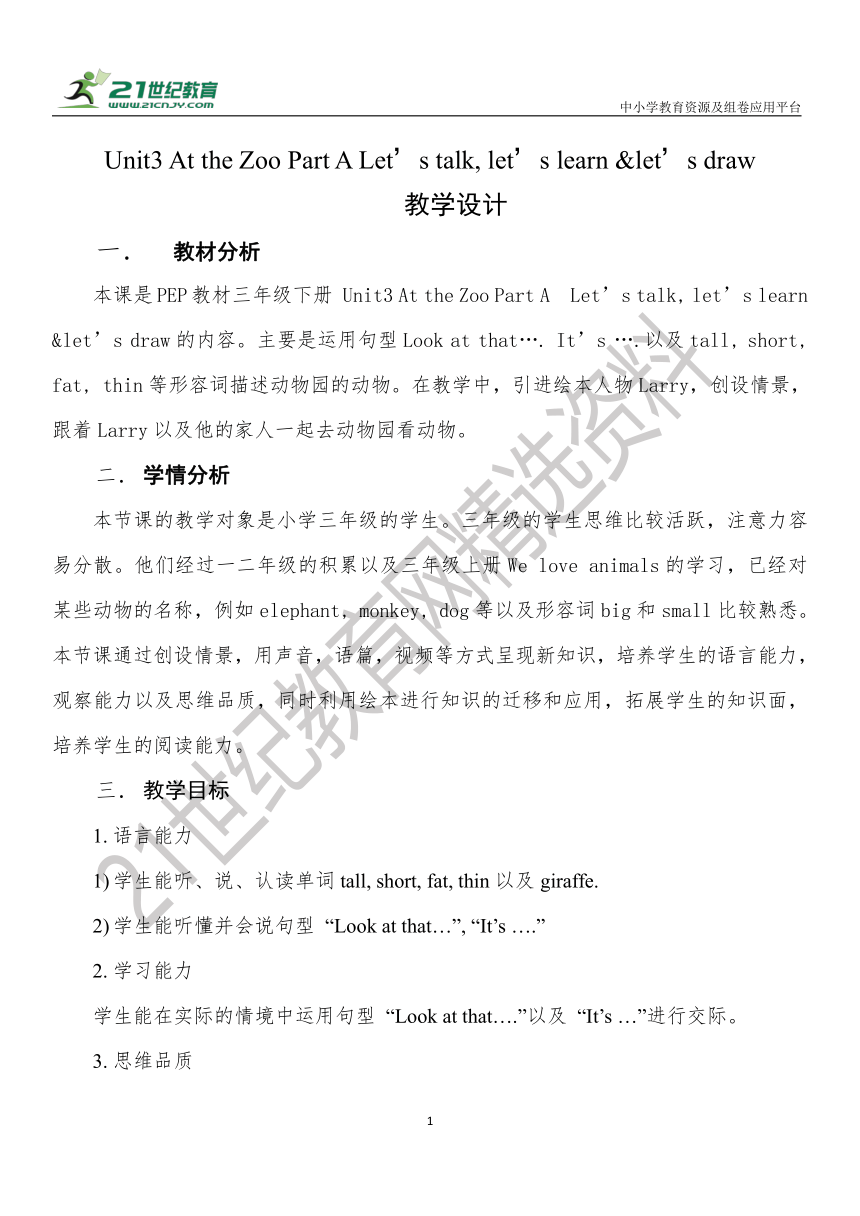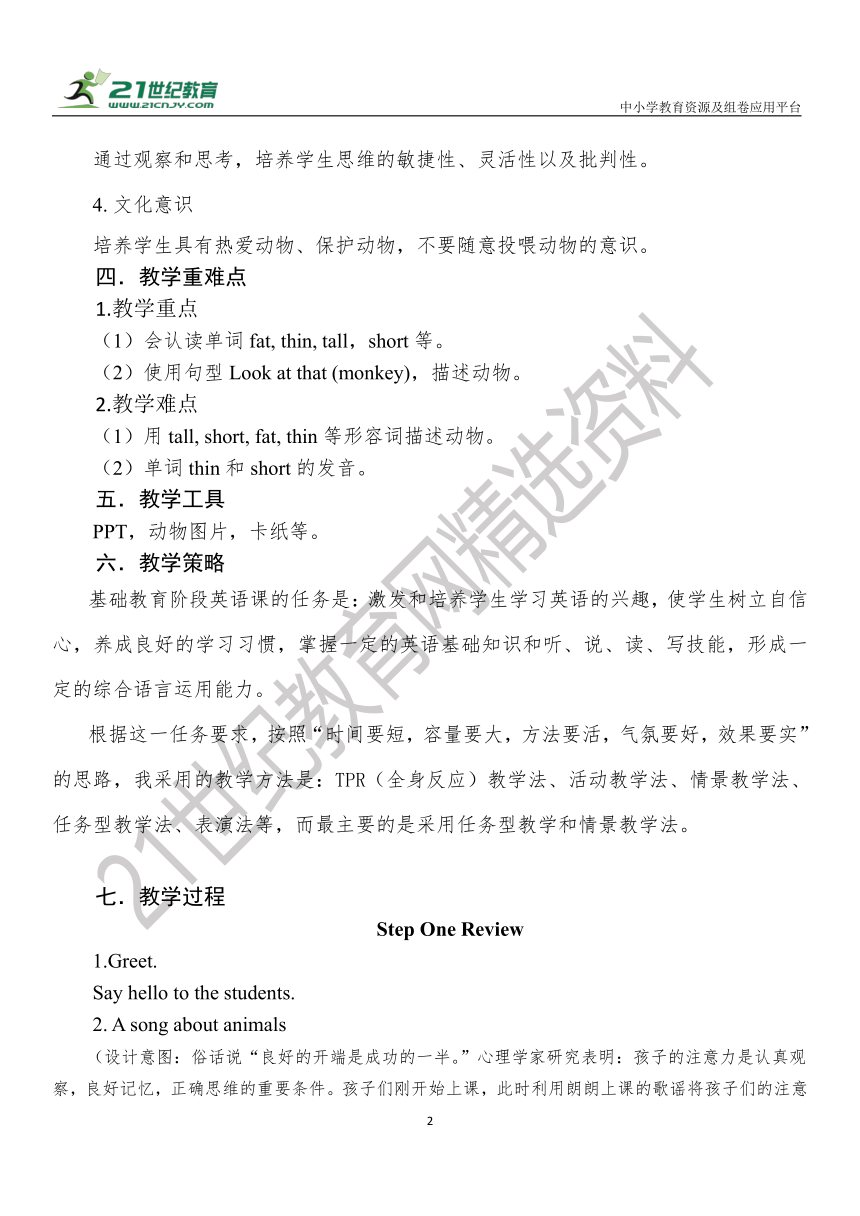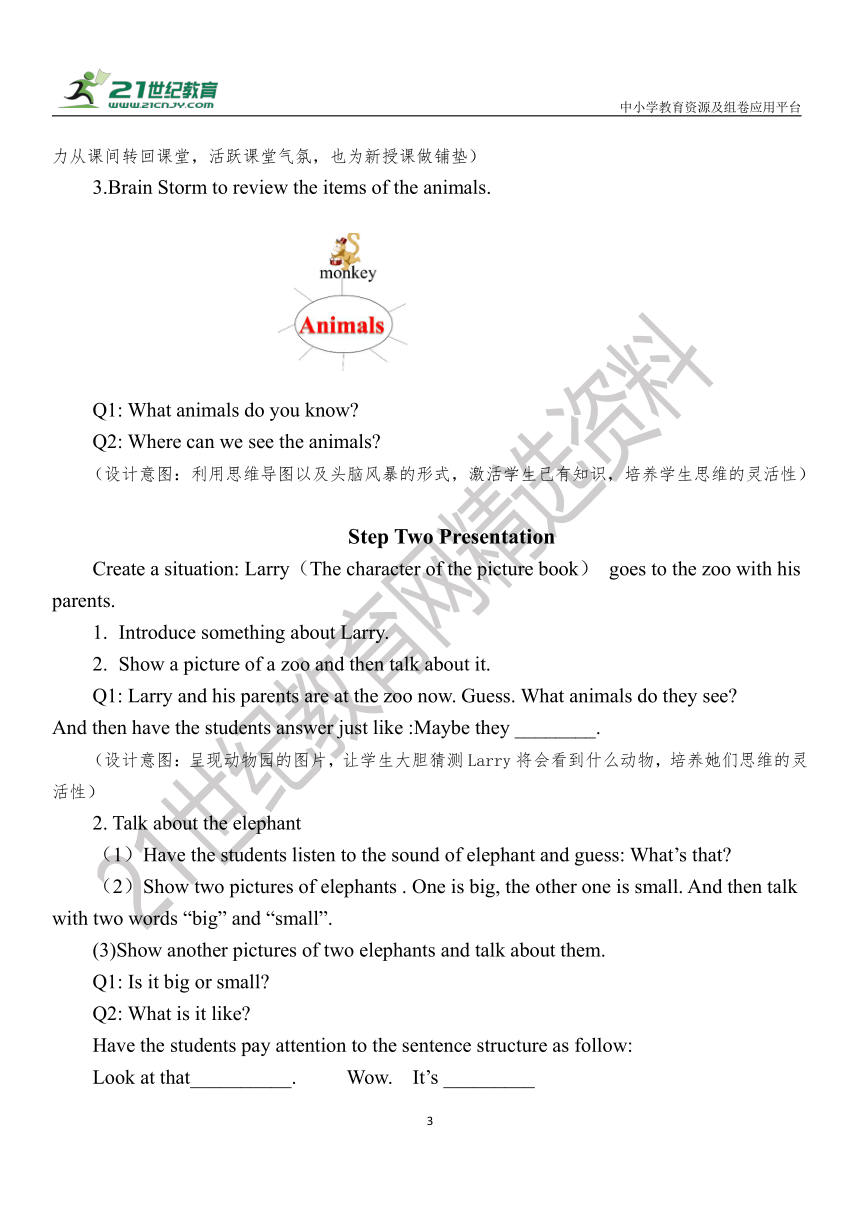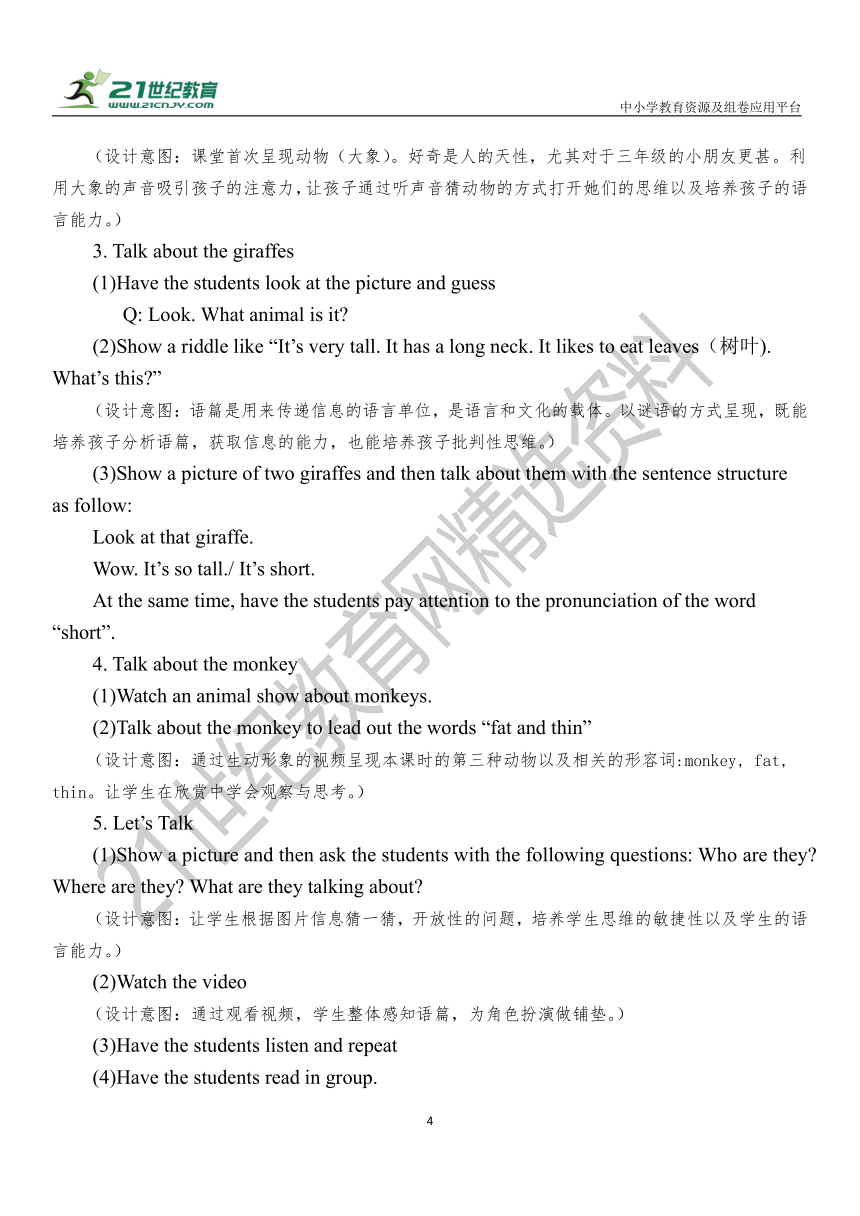Unit3 At the Zoo Part A Let’s talk, let’s learn &let’s draw教学设计(含反思)
文档属性
| 名称 | Unit3 At the Zoo Part A Let’s talk, let’s learn &let’s draw教学设计(含反思) |

|
|
| 格式 | docx | ||
| 文件大小 | 1.0MB | ||
| 资源类型 | 试卷 | ||
| 版本资源 | 人教版(PEP) | ||
| 科目 | 英语 | ||
| 更新时间 | 2023-01-29 16:09:39 | ||
图片预览




文档简介
中小学教育资源及组卷应用平台
Unit3 At the Zoo Part A Let’s talk, let’s learn &let’s draw
教学设计
教材分析
本课是PEP教材三年级下册 Unit3 At the Zoo Part A Let’s talk, let’s learn &let’s draw的内容。主要是运用句型Look at that…. It’s ….以及tall, short, fat, thin等形容词描述动物园的动物。在教学中,引进绘本人物Larry,创设情景,跟着Larry以及他的家人一起去动物园看动物。
学情分析
本节课的教学对象是小学三年级的学生。三年级的学生思维比较活跃,注意力容易分散。他们经过一二年级的积累以及三年级上册We love animals的学习,已经对某些动物的名称,例如elephant, monkey, dog等以及形容词big和small比较熟悉。本节课通过创设情景,用声音,语篇,视频等方式呈现新知识,培养学生的语言能力,观察能力以及思维品质,同时利用绘本进行知识的迁移和应用,拓展学生的知识面,培养学生的阅读能力。
教学目标
语言能力
学生能听、说、认读单词tall, short, fat, thin以及giraffe.
学生能听懂并会说句型 “Look at that…”, “It’s ….”
学习能力
学生能在实际的情境中运用句型 “Look at that….”以及 “It’s …”进行交际。
思维品质
通过观察和思考,培养学生思维的敏捷性、灵活性以及批判性。
文化意识
培养学生具有热爱动物、保护动物,不要随意投喂动物的意识。
四.教学重难点
1.教学重点
(1)会认读单词fat, thin, tall,short等。
(2)使用句型Look at that (monkey),描述动物。
2.教学难点
(1)用tall, short, fat, thin等形容词描述动物。
(2)单词thin和short的发音。
五.教学工具
PPT,动物图片,卡纸等。
六.教学策略
基础教育阶段英语课的任务是:激发和培养学生学习英语的兴趣,使学生树立自信心,养成良好的学习习惯,掌握一定的英语基础知识和听、说、读、写技能,形成一定的综合语言运用能力。
根据这一任务要求,按照“时间要短,容量要大,方法要活,气氛要好,效果要实”的思路,我采用的教学方法是:TPR(全身反应)教学法、活动教学法、情景教学法、任务型教学法、表演法等,而最主要的是采用任务型教学和情景教学法。
七.教学过程
Step One Review
1.Greet.
Say hello to the students.
2. A song about animals
(设计意图:俗话说“良好的开端是成功的一半。”心理学家研究表明:孩子的注意力是认真观察,良好记忆,正确思维的重要条件。孩子们刚开始上课,此时利用朗朗上课的歌谣将孩子们的注意力从课间转回课堂,活跃课堂气氛,也为新授课做铺垫)
3.Brain Storm to review the items of the animals.
Q1: What animals do you know
Q2: Where can we see the animals
(设计意图:利用思维导图以及头脑风暴的形式,激活学生已有知识,培养学生思维的灵活性)
Step Two Presentation
Create a situation: Larry(The character of the picture book) goes to the zoo with his parents.
Introduce something about Larry.
Show a picture of a zoo and then talk about it.
Q1: Larry and his parents are at the zoo now. Guess. What animals do they see
And then have the students answer just like :Maybe they ________.
(设计意图:呈现动物园的图片,让学生大胆猜测Larry将会看到什么动物,培养她们思维的灵活性)
2. Talk about the elephant
Have the students listen to the sound of elephant and guess: What’s that
(2)Show two pictures of elephants . One is big, the other one is small. And then talk with two words “big” and “small”.
(3)Show another pictures of two elephants and talk about them.
Q1: Is it big or small
Q2: What is it like
Have the students pay attention to the sentence structure as follow:
Look at that__________. Wow. It’s _________
(设计意图:课堂首次呈现动物(大象)。好奇是人的天性,尤其对于三年级的小朋友更甚。利用大象的声音吸引孩子的注意力,让孩子通过听声音猜动物的方式打开她们的思维以及培养孩子的语言能力。)
3. Talk about the giraffes
(1)Have the students look at the picture and guess
Q: Look. What animal is it
(2)Show a riddle like “It’s very tall. It has a long neck. It likes to eat leaves(树叶). What’s this ”
(设计意图:语篇是用来传递信息的语言单位,是语言和文化的载体。以谜语的方式呈现,既能培养孩子分析语篇,获取信息的能力,也能培养孩子批判性思维。)
(3)Show a picture of two giraffes and then talk about them with the sentence structure as follow:
Look at that giraffe.
Wow. It’s so tall./ It’s short.
At the same time, have the students pay attention to the pronunciation of the word “short”.
4. Talk about the monkey
(1)Watch an animal show about monkeys.
(2)Talk about the monkey to lead out the words “fat and thin”
(设计意图:通过生动形象的视频呈现本课时的第三种动物以及相关的形容词:monkey, fat, thin。让学生在欣赏中学会观察与思考。)
5. Let’s Talk
(1)Show a picture and then ask the students with the following questions: Who are they Where are they What are they talking about
(设计意图:让学生根据图片信息猜一猜,开放性的问题,培养学生思维的敏捷性以及学生的语言能力。)
(2)Watch the video
(设计意图:通过观看视频,学生整体感知语篇,为角色扮演做铺垫。)
(3)Have the students listen and repeat
(4)Have the students read in group.
(设计意图:通过语篇朗读,小组合作,内化语言知识。)
(5)Act out the dialogue.
(设计意图:通过角色扮演,学生更能体验语篇中的知识点以及人物的感彩。)
Step Three Practice
look at the animals at the zoo and then talk in pairs with the key words and sentence structure as following:
A: Hello! Look at that ____________.
B: Wow! It’s __________________.
A: Cool. I like it.
Have some students to act out.
(设计意图:通过同桌对话,进行知识的内化,语言的输出。)
3. Emotion Education
Talk about the rules of the zoo. For example, No feeding. No running. No climbing and so on.
(设计意图:情感的升华,在语言知识的学习中,渗透情感和文化,让学生知道动物园的一些规则知识。
Step Four Extension
1. A picture book “The Zoo”
(1)Have the students guess what animals Larry wants to draw.
(2)Watch the video about the story.
(3)Show the animals that Larry draw in form of mind-map
(4)Talk about the giraffe and elephant that Larry draw.
(5)Have the students read the pictures in group and then talk about the other animals that Larry draw.
(6)Group work: There are not any pig at the zoo. Why
(设计意图:绘本拓展,进行知识的迁移。在这一环节,首先让学生带着问题听绘本,接着让学生以小组合作的方式分析文本获取关键信息,用本节课所学知识进行归纳与总结,培养学生的学习能力,最后让他们思考与讨论:为什么动物园里没有pig学生的批判性思维的以培养和锻炼。)
2.Draw and show
(设计意图:让学生画一画,说一说,再次内化语言点,培养学生的学习能力。)
Step Five Homework
1. Read the picture book with your friends.和朋友一起读绘本
2.Introduce the picture to your parents .用英语向父母介绍你的画的动物
Tips: Look at,big, small, thin, fat, tall, short…
(设计意图:分层作业,学生根据自己的英语水平选择其中一种或两种作业。)
八.板书设计
九.教学思考
非常荣幸有机会参与这一次的教研活动并执教一节三年级下册Unit3 At the Zoo Let’s talk&Let’s learn与绘本融合的展示课。一次经历,一次磨练,一次成长。下面我将从以下几个方面谈谈我对这节课的思考和总结。
(一)研读教材,精选绘本
本课是PEP教材三年级下册 Unit3 At the Zoo Part A Let’s talk, let’s learn &let’s draw的内容。主要是运用句型Look at that…. It’s ….以及tall, short, fat, thin等形容词描述动物园的动物。如果只是局限于教材的句型和单词,是没有办法“喂饱”三年级的孩子们。怎么办呢?通过商讨,我们决定进行教材与绘本的融合,使语言知识得以内化和迁移。通过对教材的分析,对不同系列英语绘本进行筛选,我们最终选择了“Little Schoolbag”系列绘本之三年级下 “The Zoo”作为对主教材的有效补充。绘本 “The Zoo”的知识架构,既是对本课时的复习与巩固,也为本单元接下来的学习埋下伏笔。例如: Larry draws a monkey. The monkey is cute. It has a long tail.
(二)立足学情,巧设活动
三年级的学生经过一二年级的积累以及三年级上册We love animals的学习,已经对某些动物的名称,例如elephant, monkey, dog等以及形容词big和small比较熟悉。在进行教学设计时,首先从学生已有的学习经验入手,由易到难,层层递进。同时,三年级的学生思维比较活跃,注意力容易分散。本节课通过创设情景,用声音,语篇,视频等方式呈现新知识,培养学生的语言能力,观察能力以及思维品质,同时利用绘本拓展学生的知识面,培养学生的阅读能力。
1.首先,从孩子们好奇、好动、充满想象的天性为出发点,创设情景,以拓展绘本“The Zoo”的主人公“Larry”游动物园为主线,使孩子们在整体中感知语言。
2.接着,利用多媒体创设了多种情景(听声音猜测Larry第一种要看的动物是大象;根据语篇呈现长颈鹿;通过视频展现猴子等),为学生呈现新知识。通过pair work,role play以及小组活动等形式帮助学生学习、理解课文对话,从而解决本课时的重难点。引导学生善于观察,从而让学生从中领悟:We can feed the animals at the zoo.从而培养学生的文化意识,思维品质和学习能力。
3.然后,以绘本为载体,实现知识的迁移和应用。绘本 “The Zoo”, 句子朗朗上口,插图形象生动,符合三年级孩子的认知水平。(1)让学生猜一猜Larry将会在他的动物园画上什么动物,拓展学生的思维间,培养学校的发散思维;引导学生用完整的句子回答,例如 Maybe he draws a monkey 从而培养学生的语言能力。(2)以思维导图的形式,引导学生对绘本故事的脉络进行自主构建,增强语篇意识。(3)小组合作,鼓励学生以小组为单位描述Larry画的每一种动物,从而培养学生的提取文本信息的能力以及语言运用能力。(4)重视思维发展,助力核心素养。让学生根据最后一幅图 “There aren’t any pigs at the zoo.”各抒己见,拓展学生思维的空间,学生的批判性思维能力得以锻炼
4.最后,让学生自己画一画,说一说,从而实现知识的迁移和应用。
(三)反思不足
1.教学活动的设计不够深度,只是停留在表面。通过big和small呈现大象,tall和short呈现长颈鹿,fat和thin描述猴子。语言点和教学活动比较单一,没有很好地培养学生的发散性思维。教师的输入不够,导致后面环节学生的输出受限。
2.教师没能很好的融入课堂,引导学生学习方面有待加强。课后田老师用body language很好地给现场的老师演绎了几种动物的特征。在我的课堂上,如果我的肢体语言有田老师一半的效果,相信孩子们对语言点的理解和吸收会大大提高。
1
Unit3 At the Zoo Part A Let’s talk, let’s learn &let’s draw
教学设计
教材分析
本课是PEP教材三年级下册 Unit3 At the Zoo Part A Let’s talk, let’s learn &let’s draw的内容。主要是运用句型Look at that…. It’s ….以及tall, short, fat, thin等形容词描述动物园的动物。在教学中,引进绘本人物Larry,创设情景,跟着Larry以及他的家人一起去动物园看动物。
学情分析
本节课的教学对象是小学三年级的学生。三年级的学生思维比较活跃,注意力容易分散。他们经过一二年级的积累以及三年级上册We love animals的学习,已经对某些动物的名称,例如elephant, monkey, dog等以及形容词big和small比较熟悉。本节课通过创设情景,用声音,语篇,视频等方式呈现新知识,培养学生的语言能力,观察能力以及思维品质,同时利用绘本进行知识的迁移和应用,拓展学生的知识面,培养学生的阅读能力。
教学目标
语言能力
学生能听、说、认读单词tall, short, fat, thin以及giraffe.
学生能听懂并会说句型 “Look at that…”, “It’s ….”
学习能力
学生能在实际的情境中运用句型 “Look at that….”以及 “It’s …”进行交际。
思维品质
通过观察和思考,培养学生思维的敏捷性、灵活性以及批判性。
文化意识
培养学生具有热爱动物、保护动物,不要随意投喂动物的意识。
四.教学重难点
1.教学重点
(1)会认读单词fat, thin, tall,short等。
(2)使用句型Look at that (monkey),描述动物。
2.教学难点
(1)用tall, short, fat, thin等形容词描述动物。
(2)单词thin和short的发音。
五.教学工具
PPT,动物图片,卡纸等。
六.教学策略
基础教育阶段英语课的任务是:激发和培养学生学习英语的兴趣,使学生树立自信心,养成良好的学习习惯,掌握一定的英语基础知识和听、说、读、写技能,形成一定的综合语言运用能力。
根据这一任务要求,按照“时间要短,容量要大,方法要活,气氛要好,效果要实”的思路,我采用的教学方法是:TPR(全身反应)教学法、活动教学法、情景教学法、任务型教学法、表演法等,而最主要的是采用任务型教学和情景教学法。
七.教学过程
Step One Review
1.Greet.
Say hello to the students.
2. A song about animals
(设计意图:俗话说“良好的开端是成功的一半。”心理学家研究表明:孩子的注意力是认真观察,良好记忆,正确思维的重要条件。孩子们刚开始上课,此时利用朗朗上课的歌谣将孩子们的注意力从课间转回课堂,活跃课堂气氛,也为新授课做铺垫)
3.Brain Storm to review the items of the animals.
Q1: What animals do you know
Q2: Where can we see the animals
(设计意图:利用思维导图以及头脑风暴的形式,激活学生已有知识,培养学生思维的灵活性)
Step Two Presentation
Create a situation: Larry(The character of the picture book) goes to the zoo with his parents.
Introduce something about Larry.
Show a picture of a zoo and then talk about it.
Q1: Larry and his parents are at the zoo now. Guess. What animals do they see
And then have the students answer just like :Maybe they ________.
(设计意图:呈现动物园的图片,让学生大胆猜测Larry将会看到什么动物,培养她们思维的灵活性)
2. Talk about the elephant
Have the students listen to the sound of elephant and guess: What’s that
(2)Show two pictures of elephants . One is big, the other one is small. And then talk with two words “big” and “small”.
(3)Show another pictures of two elephants and talk about them.
Q1: Is it big or small
Q2: What is it like
Have the students pay attention to the sentence structure as follow:
Look at that__________. Wow. It’s _________
(设计意图:课堂首次呈现动物(大象)。好奇是人的天性,尤其对于三年级的小朋友更甚。利用大象的声音吸引孩子的注意力,让孩子通过听声音猜动物的方式打开她们的思维以及培养孩子的语言能力。)
3. Talk about the giraffes
(1)Have the students look at the picture and guess
Q: Look. What animal is it
(2)Show a riddle like “It’s very tall. It has a long neck. It likes to eat leaves(树叶). What’s this ”
(设计意图:语篇是用来传递信息的语言单位,是语言和文化的载体。以谜语的方式呈现,既能培养孩子分析语篇,获取信息的能力,也能培养孩子批判性思维。)
(3)Show a picture of two giraffes and then talk about them with the sentence structure as follow:
Look at that giraffe.
Wow. It’s so tall./ It’s short.
At the same time, have the students pay attention to the pronunciation of the word “short”.
4. Talk about the monkey
(1)Watch an animal show about monkeys.
(2)Talk about the monkey to lead out the words “fat and thin”
(设计意图:通过生动形象的视频呈现本课时的第三种动物以及相关的形容词:monkey, fat, thin。让学生在欣赏中学会观察与思考。)
5. Let’s Talk
(1)Show a picture and then ask the students with the following questions: Who are they Where are they What are they talking about
(设计意图:让学生根据图片信息猜一猜,开放性的问题,培养学生思维的敏捷性以及学生的语言能力。)
(2)Watch the video
(设计意图:通过观看视频,学生整体感知语篇,为角色扮演做铺垫。)
(3)Have the students listen and repeat
(4)Have the students read in group.
(设计意图:通过语篇朗读,小组合作,内化语言知识。)
(5)Act out the dialogue.
(设计意图:通过角色扮演,学生更能体验语篇中的知识点以及人物的感彩。)
Step Three Practice
look at the animals at the zoo and then talk in pairs with the key words and sentence structure as following:
A: Hello! Look at that ____________.
B: Wow! It’s __________________.
A: Cool. I like it.
Have some students to act out.
(设计意图:通过同桌对话,进行知识的内化,语言的输出。)
3. Emotion Education
Talk about the rules of the zoo. For example, No feeding. No running. No climbing and so on.
(设计意图:情感的升华,在语言知识的学习中,渗透情感和文化,让学生知道动物园的一些规则知识。
Step Four Extension
1. A picture book “The Zoo”
(1)Have the students guess what animals Larry wants to draw.
(2)Watch the video about the story.
(3)Show the animals that Larry draw in form of mind-map
(4)Talk about the giraffe and elephant that Larry draw.
(5)Have the students read the pictures in group and then talk about the other animals that Larry draw.
(6)Group work: There are not any pig at the zoo. Why
(设计意图:绘本拓展,进行知识的迁移。在这一环节,首先让学生带着问题听绘本,接着让学生以小组合作的方式分析文本获取关键信息,用本节课所学知识进行归纳与总结,培养学生的学习能力,最后让他们思考与讨论:为什么动物园里没有pig学生的批判性思维的以培养和锻炼。)
2.Draw and show
(设计意图:让学生画一画,说一说,再次内化语言点,培养学生的学习能力。)
Step Five Homework
1. Read the picture book with your friends.和朋友一起读绘本
2.Introduce the picture to your parents .用英语向父母介绍你的画的动物
Tips: Look at,big, small, thin, fat, tall, short…
(设计意图:分层作业,学生根据自己的英语水平选择其中一种或两种作业。)
八.板书设计
九.教学思考
非常荣幸有机会参与这一次的教研活动并执教一节三年级下册Unit3 At the Zoo Let’s talk&Let’s learn与绘本融合的展示课。一次经历,一次磨练,一次成长。下面我将从以下几个方面谈谈我对这节课的思考和总结。
(一)研读教材,精选绘本
本课是PEP教材三年级下册 Unit3 At the Zoo Part A Let’s talk, let’s learn &let’s draw的内容。主要是运用句型Look at that…. It’s ….以及tall, short, fat, thin等形容词描述动物园的动物。如果只是局限于教材的句型和单词,是没有办法“喂饱”三年级的孩子们。怎么办呢?通过商讨,我们决定进行教材与绘本的融合,使语言知识得以内化和迁移。通过对教材的分析,对不同系列英语绘本进行筛选,我们最终选择了“Little Schoolbag”系列绘本之三年级下 “The Zoo”作为对主教材的有效补充。绘本 “The Zoo”的知识架构,既是对本课时的复习与巩固,也为本单元接下来的学习埋下伏笔。例如: Larry draws a monkey. The monkey is cute. It has a long tail.
(二)立足学情,巧设活动
三年级的学生经过一二年级的积累以及三年级上册We love animals的学习,已经对某些动物的名称,例如elephant, monkey, dog等以及形容词big和small比较熟悉。在进行教学设计时,首先从学生已有的学习经验入手,由易到难,层层递进。同时,三年级的学生思维比较活跃,注意力容易分散。本节课通过创设情景,用声音,语篇,视频等方式呈现新知识,培养学生的语言能力,观察能力以及思维品质,同时利用绘本拓展学生的知识面,培养学生的阅读能力。
1.首先,从孩子们好奇、好动、充满想象的天性为出发点,创设情景,以拓展绘本“The Zoo”的主人公“Larry”游动物园为主线,使孩子们在整体中感知语言。
2.接着,利用多媒体创设了多种情景(听声音猜测Larry第一种要看的动物是大象;根据语篇呈现长颈鹿;通过视频展现猴子等),为学生呈现新知识。通过pair work,role play以及小组活动等形式帮助学生学习、理解课文对话,从而解决本课时的重难点。引导学生善于观察,从而让学生从中领悟:We can feed the animals at the zoo.从而培养学生的文化意识,思维品质和学习能力。
3.然后,以绘本为载体,实现知识的迁移和应用。绘本 “The Zoo”, 句子朗朗上口,插图形象生动,符合三年级孩子的认知水平。(1)让学生猜一猜Larry将会在他的动物园画上什么动物,拓展学生的思维间,培养学校的发散思维;引导学生用完整的句子回答,例如 Maybe he draws a monkey 从而培养学生的语言能力。(2)以思维导图的形式,引导学生对绘本故事的脉络进行自主构建,增强语篇意识。(3)小组合作,鼓励学生以小组为单位描述Larry画的每一种动物,从而培养学生的提取文本信息的能力以及语言运用能力。(4)重视思维发展,助力核心素养。让学生根据最后一幅图 “There aren’t any pigs at the zoo.”各抒己见,拓展学生思维的空间,学生的批判性思维能力得以锻炼
4.最后,让学生自己画一画,说一说,从而实现知识的迁移和应用。
(三)反思不足
1.教学活动的设计不够深度,只是停留在表面。通过big和small呈现大象,tall和short呈现长颈鹿,fat和thin描述猴子。语言点和教学活动比较单一,没有很好地培养学生的发散性思维。教师的输入不够,导致后面环节学生的输出受限。
2.教师没能很好的融入课堂,引导学生学习方面有待加强。课后田老师用body language很好地给现场的老师演绎了几种动物的特征。在我的课堂上,如果我的肢体语言有田老师一半的效果,相信孩子们对语言点的理解和吸收会大大提高。
1
